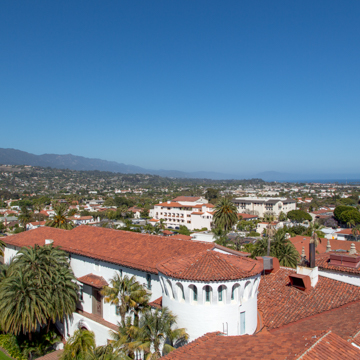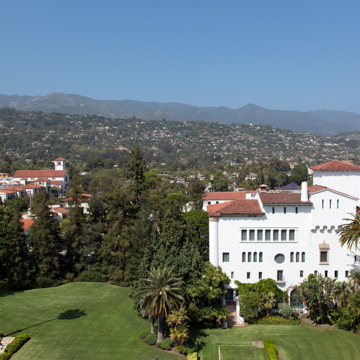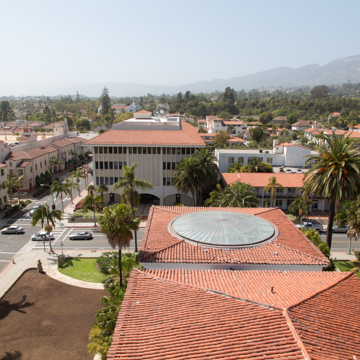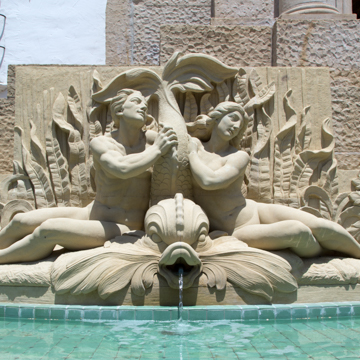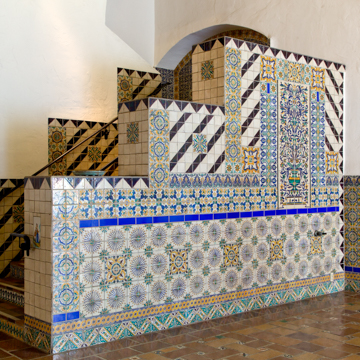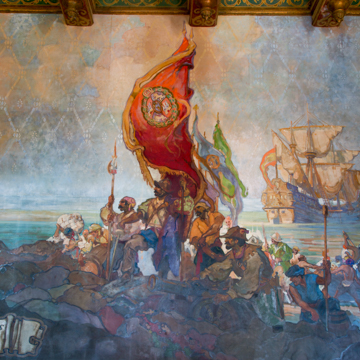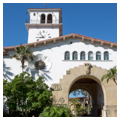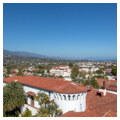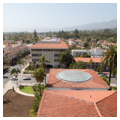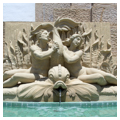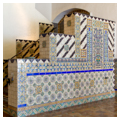On June 29, 1925, a 6.8 magnitude earthquake hit Santa Barbara, causing $8 million in property damage and killing 13 people. One of the structures that was damaged beyond repair was a small Greek Revival courthouse serving the County of Santa Barbara. The County Board of Supervisors selected the architectural firm William Mooser and Son to design a new courthouse on the same site.
The younger partner in the firm, William Mooser III, served as chief architect. His background included an architectural education at the Ecole des Beaux-Arts and a seventeen-year residence in France and Spain. His classical training was welcomed in Santa Barbara, where a grassroots architectural design movement to convert the aesthetic of the city from eclectic to Spanish Colonial Revival was then occurring. The City Beautiful Movement came to Santa Barbara in the form of a citizen-run preservation organization, The Plan and Planting Committee of the Community Arts Association, spearheaded by local activist Pearl Chase. The group sought to embrace the city’s Spanish heritage although its efforts largely served to mythologize that past.
Chase and the Community Arts Association were politically connected, working with planner Charles Cheney to develop ordinances for the city. Since the earthquake destroyed much of State Street, the main commercial corridor of Santa Barbara, as well as several government buildings, including the County Courthouse, it became feasible to focus architectural guidelines and standardize the city’s design. The Association urged City Council to enact a design review ordinance that Cheney had previously drafted; the Architectural Review Board processed 2,000 building permits in its first year after the earthquake. With Chase and the Community Arts Association guiding the Architectural Review Board, Spanish Colonial Revival became a staple in the community’s design. The new courthouse, with its abundant decorative uses of sandstone, wrought iron, and terra-cotta, would become one of the greatest examples of Spanish Colonial Revival in the city.
Construction began in October 1926 and was completed in March 1929, although the official dedication did not occur until August 14, 1929 at the annual Old Spanish Days Fiesta. The L-shaped courthouse is composed of four structures—the Hall of Records, Service Annex, Administration and Court Wing, and Jail—that are connected by bridges and arches, creating one complex of approximately 148,000 square feet. The courthouse occupies the southeast and southwest of an entire city block. The remainder of the block is landscaped with gardens designed by Santa Barbara landscape architect Ralph Stevens, including a “sunken” garden occupying the footprint of the old courthouse. The courthouse is oriented to receive natural light and heat from southern sun exposure. Additionally, the site design follows a modified Spanish castle plan, playing with the rhetoric of defensive architectural elements, Santa Barbara’s Spanish roots, and the courthouse’s use as the seat of the government for the county.
The 370-foot southwestern facade along Anacapa Street is the dominant wing of the courthouse, and contains the Hall of Records, Service Annex, Main Arch, and one leg of the Administration and Court Wing. The Main Arch is possibly the most recognizable feature, with a height of approximately 39 feet and details of articulated sandstone quarried from Refugio Canyon, approximately 20 miles away. It is flanked by Corinthian columns and an entablature with a Latin inscription that translates to “God hath provided the ground, Man has built the town.” The Main Arch provides a physical and architectural connection from the Service Annex to the Main Administration and Court Wing.
The elevations of the Service Annex, which measures approximately 64 by 68 feet and is approximately 46 feet tall, are decorated with detailed wrought-iron grilles, wooden shutters, wrought-iron railings, and stone plinths. Ettore Cadorin created the five sandstone sculptures on the southwestern facade in conjunction with the main arch. The most prominent sculpture is the Spirit of the Ocean fountain, composed of a large basin, two siblings holding a dolphin fish, and ornately carved seaweed. A stone plinth wraps from the fountain to the Main Arch. The stone plinth begins again at the southwest corner and connects to the Hall of Records’ entrance.
The Hall of Records is surrounded by a stone-lined drainage swale, similar to a moat and thus continuing the castle aesthetic of the design. The “moat” is connected to the plinth that supports the entrance. To access the structure, visitors pass through an arched portico, complete with sandstone archways. Once inside, a 45-foot-diameter skylight draws the eye upward to the third-floor height. A second-story bridge connects the Hall of Records to the Service Annex. One of the more decorative elements of the structure are the defensive doors. Metalsmith Albert Yann created two 4 x 13–foot doors with hammered copper panels depicting California history. Not meant to serve as functioning doors (another pair of doors are set inside the entranceway), they are another castle-themed element within the overall design.
The largest individual structure of the complex, the Administrative and Court Wing, is composed of two galleries, the Anacapa Gallery and Figueroa Gallery, named after the respective streets that the structure parallels. At the intersection of the two galleries is a rotunda with a machicolated roof. The most prominent architectural element of the galleries is the clock tower, rising 111 feet above street level, with an 88-foot observation deck. The tower has a large clock on each face, and faux bells ring to announce the time throughout the day. The observation tower takes on the role of a castle’s “keep,” as visitors can access the deck, protected by wrought-iron guard rails, and take in 360-degree views of the city. The two wings contain many architectural details of interest, including heavy, 3 x 8–foot wood doors, lancets, stone finials, terra-cotta, hammered copper wall sconces, and wrought-iron detail work seen in windows, access gates, and railings.
A small bridge connects the Administrative and Court Wing to the Jail, and is known as the Bridges of Sighs, inspired by the bridge in Venice, Italy, where prisoners would take in one last view of the Venetian landscape before being taken to their cells. When the Santa Barbara County Courthouse jail structure was still functioning as a prison, it is said that prisoners had a similar experience. The Jail itself has another sandstone archway, with a Latin inscription that translates to “Learn Justice From This Warning.” The Jail also features additional castle elements, such as a large cast-stone breastplate shield, a concrete and stone turret, lancets, embrasures, and additional wrought-iron grilled windows.
The interior of the Courthouse is as ornate as the exterior. Hand-painted ceramic tiles adorn the floors, underside of beams, and built-in furniture throughout the complex. The Mural Room was designed to be the Board of Supervisor’s Meeting Room; Mooser III once said that he intended the design to be a Throne Room for the Supervisors. Giovanni Battista Smeraldi created the ceiling in a “Mudejar” style, a mixture of Spanish and Moorish designs. The floor is composed of handmade terra-cotta floor tiles created by Glading, McBean, and Company. These floor tiles also extend throughout the entire interior of the complex. Mooser III hired Dan Sayer Groesbeck to execute the murals in the 40 x 70 x 30–foot space. The murals depict the early history of Santa Barbara, including a Native American village, the landing of Rodriguez Cabrillo in 1542, Spanish shields, Mexicans and Native Americans joined by Franciscan monks, the Santa Barbara Presidio’s lost canon of 1790, John Fremont with his troops, and the 1786 construction of the Santa Barbara Mission.
The Santa Barbara County Courthouse is one of the most visited sites in the city of Santa Barbara, and has been designated a historic resource on the local, state, and federal levels.
References
“Resolution No. 82-136.” City of Santa Barbara. Accessed January 18, 2016. http://www.santabarbaracourthouse.org/.
Gebhard, David. “The Community as Client: Architectural Review in America.” AIA California Council. Accessed August 6, 2017. http://www.aiacc.org/.
“History of the Courthouse.” Santa Barbara Courthouse. Accessed January 18, 2016. sbcourthouse.org/.
Jervis, Laurie. “Historic Santa Barbara County Courthouse Is the Center of More Than Our Attention.” Noozhawk, August 5, 2014.
Jervis, Laurie. “Courthouse Mural Room Makes Santa Barbara County’s History a Work of Art.” Noozhawk, August 9, 2014.
Moore, Charles. The City Observed: Los Angeles. New York: Random House, 1984.
Ooley, Robert, “Santa Barbara County Courthouse,” Santa Barbara County, California. National Historic Landmark Nomination, 2005. National Park Service, U.S Department of the Interior, Washington, D.C.
“Santa Barbara.” California Office of Historic Preservation. Accessed January 18, 2016. http://ohp.parks.ca.gov/.
Santa Barbara Conservancy. Stone Architecture in Santa Barbara. Charleston, SC: Arcadia Publishing, 2009.
Simpson, Lee M. A. Selling the City: Gender, Class, and the California Growth Machine, 1880-1940. Stanford, CA: Stanford University Press, 2004.















